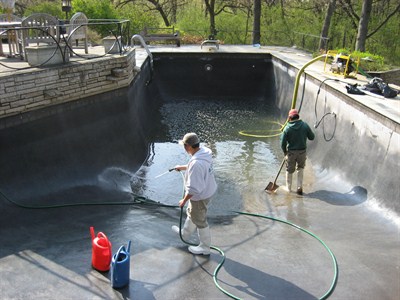What Chemicals Do You Need to Open the Pool?
What Chemicals Do You Need to Open the Pool?

If you're getting antsy to open the swimming pool for the season and you're planning on doing it yourself, you might be ready to start preparing and getting supplies ready now. If it's your first time opening an inground pool - or if it's just been a while since you've done it - you might be wondering what chemicals you'll need to open the pool.
In this post, we'll take a look at the chemicals needed for pool openings, as well as how and when to use them for the best results. As we often remind our customers and readers, opening an inground pool is a lot of work. We recommend using a professional pool opening service to ensure that your pool is opened properly.
Preparation Before Adding Pool Opening Chemicals
Once the pool cover has been removed, cleaned and stored, you need to get a sense of the pool's condition before you do anything else. If there are any stains, leaks or cracks, you'll want to have those repaired first.
You should also keep an eye out for any algae that may have formed in the pool water. If necessary, remove any large debris in the pool - though hopefully, your pool cover will have kept everything out.
Vacuum Open Pools
If your pool does not need to be drained, you can use a vacuum to clean away any smaller waste, dirt and debris in the water and on the floor of the pool. Typically, around 6" to 18" of pool water will be removed during this process.
After you have thoroughly brushed the pool walls and floor, you are ready to introduce chemicals. Shock the pool with chlorine, adding approximately one gallon of shock for every 5,500 gallons of water. The shock can be poured directly into the water around the perimeter of the pool. After shocking the pool, you can test the chlorine levels. If the levels are not within normal levels, you will need to add pH or alkalinity increase or decrease products to balance the water.

Drain and Clean Pools
Some pools will need to be drained when they are opened for the season. (Owners of vinyl-lined pools or single-piece fiberglass pools should note that these pools cannot be drained as they will float.) To complete a drain and clean, you will need to drain the pool quickly and open or remove the hydrostatic valve as soon as you can in order to relieve any potential groundwater pressure. This is an especially tricky and potentially perilous job, and you should call a professional to perform the drain if possible.
With the water drained, the pool interior can then be cleaned with acid or with chlorine, depending on the pool. After the pool items have all been installed and the deck area and equipment cleaned, you can add water back into the pool. Test to ensure that chlorine levels are within the normal range, and use pH and alkalinity products as needed to keep the water balanced.
To avoid causing any damage to your pool during the opening process, we highly recommend that you request the help of a professional. For more information, you can read our posts on how to open an inground pool and how to drain an inground pool. Contact us for a free quote.